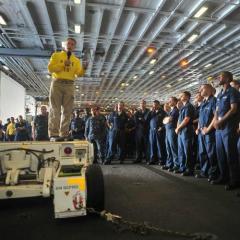Bird and airplane collisions. Birds vs. "birds" A bird hits a plane
Airplane vs bird? It would seem that the answer is obvious - the plane will definitely emerge victorious from this unequal battle, but unfortunately for the aircraft the consequences of such a “meeting” can be very, very serious. Let us recall, for example, the case of an emergency landing of an Airbus A320 on the Hudson River in New York in 2009, then immediately after takeoff, wild geese simultaneously hit both engines, which caused a complete loss of thrust. The history of civil aviation knows many cases with less happy outcome. In this article we will tell you why birds pose such a great danger to aviation.
A little physics.
Since planes and birds have to coexist in the same sky, collisions (in English) are unfortunately inevitable. Why are their consequences so serious for aircraft? It's all about physics. The speed of most aircraft at altitudes below 1000 meters (this is where 90 percent of collisions occur) is 200 - 400 kilometers per hour. Now let's remember how to calculate kinetic energy. It is proportional to the square of the speed, this is the reason for the colossal destructive ability of birds, because the energy of an object of equal mass at the moment of collision at speeds of 100 and 400 km/h differs by 16 times! That is why seemingly harmless birds turn out to be akin to military missiles for aircraft. By the way, aircraft damage depends not only on the size of the bird. No matter how cynical it may sound, from the point of view of aviation, what is primarily important is the density of the poultry carcass, i.e. size to weight ratio. So, for example, wild duck with a relatively smaller size, it causes significantly more damage than a seagull.
Aircraft damage.
The greatest danger is the entry of birds into the engine; this can lead to deformation of the blades at various stages of the compressor, after which their destruction and engine failure, in some cases even an engine fire, are possible.
A bird entering a cockpit window can cause it to crack and sometimes even shatter, which can cause serious injury to pilots.
Birds entering other parts of the fuselage usually do not pose a serious threat to flight safety, but will result in significant structural damage.

Annually civil aviation suffers multi-million dollar losses as a result of such incidents.
About birds.
Most of those birds that we usually do not pay attention to (crows, pigeons, etc.) fly no higher than 100 meters at speeds of up to 40 kilometers per hour. Birds can be seen less frequently at altitudes up to 300 meters. Above 300 meters, as a rule, either birds of prey or migratory birds, whose flight altitude can reach several kilometers. There are known cases of collisions with birds at altitudes of 6000 and even 9000 meters, but this is rather an exception.
Despite their small size, birds' hearing and vision capabilities are generally similar to those of humans. Studies have shown that birds see a flying aircraft well in advance, but do not perceive the aircraft as a threat and do not try to change its trajectory in advance to avoid a collision. In addition, birds that live in the area of the airport for a long time and see airplanes quite often become less cautious. The behavior of birds immediately before a collision is unpredictable. There is an opinion that birds tend to undertake a sharp descent rather than a climb, but studies have not shown any pattern in their behavior.
How to fight?
Each major airport has its own ornithological service, which conducts observations and statistics, studies the migration routes of birds, and carries out measures to repel them.
The most widespread are acoustic installations that imitate the cry of birds made in danger. Propane guns, which produce a sound similar to a gunshot, are also widely used. Some airports allow birds of prey, such as falcons, to be kept.

There are known cases of targeted extermination of certain populations in airport areas, for example, in 1990, gulls were shot in New York, about thirty thousand individuals were destroyed. This measure has led to a significant reduction in the number of bird collisions with aircraft.
In bowling, a strike is the best shot you can hit. In aviation jargon, however, a strike occurs when a bird suddenly crosses the plane's path. Usually with a predictable outcome for the bird. Birds and planes collide not so rarely. Not long ago, a Japanese Airlines plane was forced to make an emergency landing in New York because a bird struck the plane; another plane was forced to return to Cardiff Airport in Wales after a bird hit the engine.
In 2016, there were 1,835 confirmed bird strikes in the UK alone - eight for every 10,000 flights. This is a serious development for airlines: planes hit by birds must be carefully examined for subtle damage that could be dangerous if not found.
Only about 5% of bird hits result in damage to aircraft. But out of an abundance of caution, all affected planes are returned to the nearest airport, and passengers are transferred to another flight with a different crew. All of this has an impact on airport operations. Determining indirect costs is also not easy. It is estimated that for North America this amounts to $500 million, writes The Conversation.
Jump-jump
Birds don't fly high. A 2006 study found that three-quarters of bird strikes occur below 150 meters when a plane is taking off or landing. The aircraft's speed at this moment is lower than at altitude, and quick evasive maneuvers are difficult to carry out. The outcome largely depends on which part of the plane the bird strikes. Airplanes are built to withstand powerful forces, so while engineers may worry, there's not much to worry about.
A bird hitting an engine twice is extremely unlikely (although it has happened), but if one engine fails due to a bird strike, it will not be critical. All aircraft cope with the failure of one engine. Most of them can cross the ocean on one engine.
However, it's not just engines that are at risk from birds. Windows in the cockpit can also break. But they're made from three layers of laminated acrylic and glass, designed to withstand hail in the heart of a storm, so birds aren't a problem for them. The presence of multiple layers also ensures that the aircraft remains airtight even if the outer layers are damaged. Pilots are also trained to turn on the heated glass so that ice does not freeze at altitude before takeoff; This makes the glass softer and more resistant to impacts.
Prevention and Detection
To ensure that the birds do not suffer such a terrible fate, airports also take various measures to prevent them from even approaching aircraft. Recordings of birds of prey sounds, cartridges that produce loud noises and flashes of light, mechanical falcons, trained falcons, and drones are used. These measures work in the short term, but the birds are thought to get used to them quickly. Plus, birds love airports. Large, green, empty areas surrounded by trees and bunkers are very attractive to wildlife.
Quite often there is an assumption that engines should be protected by a grille, but this is not so easy to do. The problem is that in order to effectively block a bird at 800 kilometers per hour, the mesh would have to be quite strong and thick, but this would interfere with the flow of air into the engine. Engines are efficient because they are carefully designed to harness the thinnest air at altitude, so the cons of a grille outweigh the pros.
As commercial drones become more common, the industry is calling for systems that will tell pilots how bad the impact is so they can continue flying if there is no damage. Researchers from Cardiff and the UK's Imperial Universities, as well as around the world, are working on a variety of sensors and materials that can independently assess the health of an aircraft and eliminate the need to abort the flight.
The idea is to develop a low-power, lightweight, wireless system that can detect the location and severity of damage. It could take more than a decade to certify such a system, but eventually pilots could be told they can continue flying safely after an impact. If they need to land, technicians will know where to look and spare parts will already be at the ready.
In the meantime, prevention, design and careful pilot training will remain our only defense against bird strikes.
In bowling, a strike is the best shot you can hit. In aviation jargon, however, a strike occurs when a bird suddenly crosses the plane's path. Usually with a predictable outcome for the bird. Birds and planes collide not so rarely. Not long ago, a Japanese Airlines plane was forced to make an emergency landing in New York because a bird struck the plane; another plane was forced to return to Cardiff Airport in Wales after a bird hit the engine.
In 2016, there were 1,835 confirmed bird strikes in the UK alone - eight for every 10,000 flights. This is a serious development for airlines: planes hit by birds must be carefully examined for subtle damage that could be dangerous if not found.
Only about 5% of bird hits result in damage to aircraft. But out of an abundance of caution, all affected planes are returned to the nearest airport, and passengers are transferred to another flight with a different crew. All of this has an impact on airport operations. Determining indirect costs is also not easy. It is estimated that for North America this amounts to $500 million, writes The Conversation. 
Birds don't fly high. A 2006 study found that three-quarters of bird strikes occur below 150 meters when a plane is taking off or landing. The aircraft's speed at this moment is lower than at altitude, and quick evasive maneuvers are difficult to carry out. The outcome largely depends on which part of the plane the bird strikes. Airplanes are built to withstand powerful forces, so while engineers may worry, there's not much to worry about. 
Airplane engines, for example, are designed to be very reliable. Certification criteria include the requirement that large engines must withstand a bird strike weighing more than 3.5 kg without dangerously and rapidly releasing sharp debris from the engines. In fact, most engines can swallow a bird with only minor damage to the blades. 
A bird hitting an engine twice is extremely unlikely (although it has happened), but if one engine fails due to a bird strike, it will not be critical. All aircraft cope with the failure of one engine. Most of them can cross the ocean on one engine. 
However, it's not just engines that are at risk from birds. Windows in the cockpit can also break. But they're made from three layers of laminated acrylic and glass, designed to withstand hail in the heart of a storm, so birds aren't a problem for them. The presence of multiple layers also ensures that the aircraft remains airtight even if the outer layers are damaged. Pilots are also trained to turn on the heated glass so that ice does not freeze at altitude before takeoff; This makes the glass softer and more resistant to impacts. 
To ensure that the birds do not suffer such a terrible fate, airports also take various measures to prevent them from even approaching aircraft. Recordings of birds of prey sounds, cartridges that produce loud noises and flashes of light, mechanical falcons, trained falcons, and drones are used. These measures work in the short term, but the birds are thought to get used to them quickly. Plus, birds love airports. Large, green, empty areas surrounded by trees and bunkers are very attractive to wildlife.
Quite often there is an assumption that engines should be protected by a grille, but this is not so easy to do. The problem is that in order to effectively block a bird at 800 kilometers per hour, the mesh would have to be quite strong and thick, but this would interfere with the flow of air into the engine. Engines are efficient because they are carefully designed to harness the thinnest air at altitude, so the cons of a grille outweigh the pros.
As commercial drones become more common, the industry is calling for systems that will tell pilots how bad the impact is so they can continue flying if there is no damage. Researchers from Cardiff and the UK's Imperial Universities, as well as around the world, are working on a variety of sensors and materials that can independently assess the health of an aircraft and eliminate the need to abort the flight. 
The idea is to develop a low-power, lightweight, wireless system that can detect the location and severity of damage. It could take more than a decade to certify such a system, but eventually pilots could be told they can continue flying safely after an impact. If they need to land, technicians will know where to look and spare parts will already be at the ready. 
In the meantime, prevention, design and careful pilot training will remain our only defense against bird strikes.
The last time an air accident involving birds occurred was on April 27, 2016. An American Airlines plane collided with a flock of birds while taking off from Seattle/Tacoma International Airport, leaving a deep dent in the nose of the plane. After the news appeared in the media, people sounded the alarm: how much does this situation threaten the safety of passengers?
“Passengers think that birds can seriously damage the plane and cause a plane crash. That's not true at all; you'd be surprised, but airplanes can handle a lot of this stuff,” explains Jim Colburn, an experienced pilot and flight manager for Frontier Airlines.
In the event of a mid-air collision with birds, the aircraft will not be damaged thanks to the antenna radome - a rigid metal panel that protects weather radars located on board the ship from damage. However, according to safety rules, in such a situation the plane must return to the airport.
“Bird strikes during takeoff, although rare, are a common practice on all international airlines,” says Morgan Durrant, a spokeswoman for American airline Delta. “The aircraft’s design can withstand the impact of birds flying at speed and allows the aircraft to return to the airport normally and make a safe landing.”

According to statistics from Seattle/Tacoma International Airport, in 95% of mid-air bird strikes, there is no damage to the aircraft at all. On average, such situations occur 150–200 times per year - and this is quite a bit.
Pilots have more questions when a bird gets into the engine. In one case, pilots may not even notice until they begin inspecting the aircraft after landing at the airport. In less fortunate circumstances, the bird could damage the engine. In simulators, pilots are taught what to do if one engine fails, but when both fail, it's a bigger problem.
In January 2009, an aviation incident occurred in America. A US Airways Airbus A320 flying from New York to Seattle collided with a flock of Canada geese 90 seconds after takeoff. Both engines failed and the crew made an emergency landing on the Hudson River in New York. All passengers and crew remained safe, but more than five people were seriously injured.
American airline pilots loudly claim that the likelihood of such an incident is very low and passengers should not be afraid. “Mid-air bird strikes are more of an annoyance to pilots than a threat to the safety of the people on board,” says Jim Colburn. “Upon arrival at the airport, you have to wash the ship and carry out a technical check - this takes a lot of time.”




